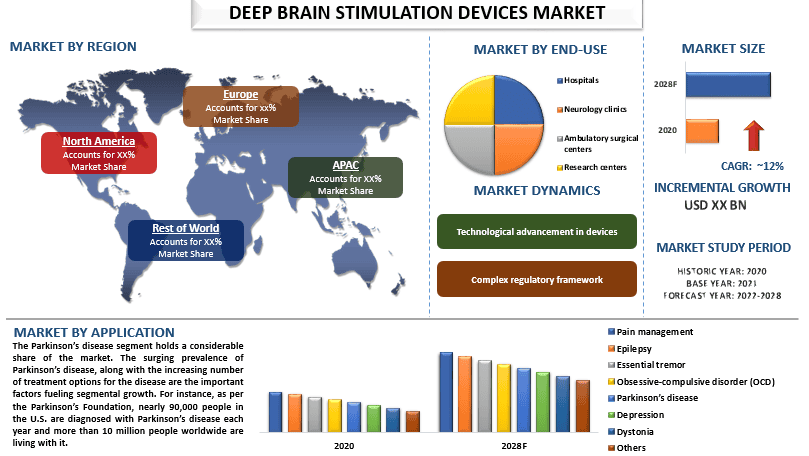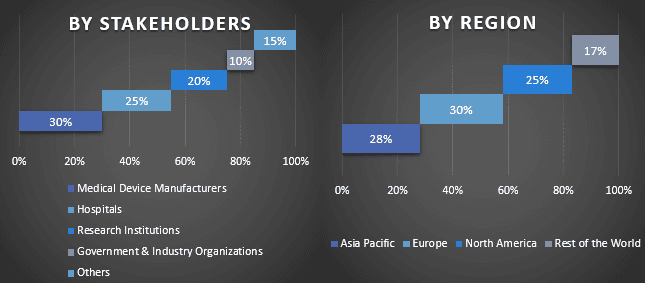- Home
- Chi siamo
- Settore
- Servizi
- Lettura
- Contattaci
Mercato dei dispositivi per la stimolazione cerebrale profonda: analisi attuale e previsioni (2022-2028)
Focus sull'applicazione (Gestione del dolore, Epilessia, Tremore essenziale, Disturbo ossessivo-compulsivo (DOC), Malattia di Parkinson, Depressione, Distonia e Altri); Uso finale (Ospedali, Cliniche neurologiche, Centri chirurgici ambulatoriali e Centri di ricerca); Regione (Nord America, Europa, Asia-Pacifico, Resto del mondo); e Regione/Paese

Si prevede che il mercato globale dei dispositivi di stimolazione cerebrale profonda crescerà a un tasso significativo di circa il 12% durante il periodo di previsione. La stimolazione cerebrale profonda (DBS) prevede l'applicazione di un dispositivo chiamato neurostimolatore, per erogare segnali elettrici alle aree del cervello che controllano il movimento, il dolore, l'umore, il peso, i pensieri ossessivo-compulsivi e il risveglio dal coma. La crescente incidenza di malattie neurologiche, insieme all'adozione di tecnologie avanzate, sono i fattori importanti responsabili della crescita del mercato dei dispositivi di stimolazione cerebrale profonda. Inoltre, i frequenti lanci di prodotti attribuiscono anche la crescente domanda di dispositivi di stimolazione cerebrale profonda. Ad esempio, Medtronic plc, leader mondiale nella tecnologia medica, ha annunciato l'approvazione da parte della U.S. Food and Drug Administration (FDA) per il suo sistema di derivazione direzionale SenSight™, che è il primo impianto statunitense utilizzato per la terapia di stimolazione cerebrale profonda (DBS).
Abbott; Boston Scientific Corporation; Medtronic; Aleva Neurotherapeutics; Nexstim Oyj; LivaNova PLC; NeuroPace, Inc.; Functional Neuromodulation Ltd.; SceneRay Co., Ltd.; e Neuronetics. sono alcuni dei principali attori del mercato. Diversi M&A insieme a partnership sono stati intrapresi da questi attori per facilitare i clienti con prodotti/tecnologie hi-tech e innovativi.
Approfondimenti presentati nel rapporto
"Tra le applicazioni, la categoria dell'epilessia assisterà a un CAGR più elevato durante il periodo di previsione"
Sulla base dell'applicazione, il mercato è stato suddiviso in gestione del dolore, epilessia, tremore essenziale, disturbo ossessivo-compulsivo (DOC), morbo di Parkinson, depressione, distonia e altri. Tra questi, si prevede che il segmento dell'epilessia crescerà al CAGR più alto del mercato. La crescente prevalenza dell'epilessia e la crescente consapevolezza delle opzioni di trattamento avanzate sono i fattori importanti responsabili della crescita segmentale. Ad esempio, secondo l'OMS, circa 50 milioni di persone in tutto il mondo soffrono di epilessia, rendendola una delle malattie neurologiche più comuni a livello globale.
"Tra gli usi finali, il segmento dei centri di chirurgia ambulatoriale crescerà con un CAGR significativo durante il periodo di previsione"
Sulla base dell'uso finale, il mercato è stato suddiviso in ospedali, cliniche neurologiche, centri di chirurgia ambulatoriale e centri di ricerca. Tra questi, si prevede che il segmento dei centri di chirurgia ambulatoriale crescerà a un CAGR significativo durante il periodo di previsione. Gli ASC forniscono il punto di cura del trattamento, possono offrire trattamenti a basso costo e riducono i tempi di attesa nei casi di emergenza. Questi fattori sono responsabili della crescita segmentale dei centri di chirurgia ambulatoriale.
"L'Asia Pacifico assisterà alla crescita più rapida del mercato"
Per una migliore comprensione dell'adozione del mercato dell'industria dei dispositivi di stimolazione cerebrale profonda, il mercato viene analizzato in base alla sua presenza mondiale in paesi come Nord America (Stati Uniti, Canada e resto del Nord America), Europa (Germania, Francia, Italia, Spagna, Regno Unito e resto d'Europa), Asia-Pacifico (Cina, Giappone, India, Australia e resto dell'APAC) e resto del mondo. Si prevede che l'Asia-Pacifico crescerà al ritmo più veloce durante il periodo di previsione. I principali fattori come l'aumento della spesa medica, l'aumento del reddito disponibile delle persone, insieme a favorevoli iniziative governative attribuiscono la crescita del mercato dei dispositivi di stimolazione cerebrale profonda nella regione. Ad esempio, secondo la Banca mondiale, la spesa sanitaria pro capite del Giappone ammontava a 3988,36 USD nel 2012, che ha raggiunto 4587,03 USD nel 2019.
Motivi per acquistare questo rapporto:
- Lo studio include l'analisi delle dimensioni del mercato e delle previsioni convalidate da esperti del settore chiave autenticati.
- Il rapporto presenta una rapida panoramica delle prestazioni complessive del settore a colpo d'occhio.
- Il rapporto copre un'analisi approfondita dei principali peer del settore con un focus primario sulle principali finanze aziendali, sul portafoglio prodotti, sulle strategie di espansione e sugli sviluppi recenti.
- Esame dettagliato dei driver, dei vincoli, delle tendenze chiave e delle opportunità prevalenti nel settore.
- Lo studio copre in modo completo il mercato attraverso diversi segmenti.
- Analisi approfondita a livello regionale del settore.
Opzioni di personalizzazione:
Il mercato globale dei dispositivi di stimolazione cerebrale profonda può essere ulteriormente personalizzato in base alle esigenze o a qualsiasi altro segmento di mercato. Inoltre, UMI comprende che potresti avere le tue esigenze aziendali, quindi sentiti libero di metterti in contatto con noi per ottenere un rapporto che si adatti completamente alle tue esigenze.
Indice
Metodologia di ricerca per l'analisi del mercato dei dispositivi per la stimolazione cerebrale profonda (2022-2028)
L'analisi del mercato storico, la stima del mercato attuale e la previsione del mercato futuro del mercato globale dei dispositivi per la stimolazione cerebrale profonda sono stati i tre passaggi principali intrapresi per creare e analizzare l'adozione dei dispositivi per la stimolazione cerebrale profonda nelle principali regioni a livello globale. È stata condotta un'esaustiva ricerca secondaria per raccogliere i dati storici del mercato e stimare le dimensioni del mercato attuale. In secondo luogo, per convalidare queste informazioni, sono stati presi in considerazione numerosi risultati e ipotesi. Inoltre, sono state condotte anche interviste primarie approfondite con esperti del settore lungo tutta la catena del valore del mercato globale dei dispositivi per la stimolazione cerebrale profonda. Successivamente all'assunzione e alla convalida dei dati di mercato attraverso le interviste primarie, abbiamo impiegato un approccio top-down/bottom-up per prevedere le dimensioni complete del mercato. Successivamente, sono stati adottati metodi di suddivisione del mercato e di triangolazione dei dati per stimare e analizzare le dimensioni di mercato dei segmenti e dei sottosegmenti pertinenti del settore. La metodologia dettagliata è spiegata di seguito:
Analisi delle dimensioni storiche del mercato
Passaggio 1: Studio approfondito di fonti secondarie:
È stato condotto uno studio secondario dettagliato per ottenere le dimensioni storiche del mercato dei dispositivi per la stimolazione cerebrale profonda attraverso fonti interne all'azienda come relazioni annuali e bilanci, presentazioni sulle prestazioni, comunicati stampa, ecc., e fonti esterne tra cui riviste, notizie e articoli, pubblicazioni governative, pubblicazioni dei concorrenti, rapporti di settore, database di terze parti e altre pubblicazioni credibili.
Passaggio 2: Segmentazione del mercato:
Dopo aver ottenuto le dimensioni storiche del mercato dei dispositivi per la stimolazione cerebrale profonda, abbiamo condotto un'analisi secondaria dettagliata per raccogliere informazioni storiche sul mercato e condividere diversi segmenti e sottosegmenti per le principali regioni. I principali segmenti inclusi nel rapporto sono l'applicazione e l'uso finale. Sono state condotte ulteriori analisi a livello di paese per valutare l'adozione complessiva dei modelli di test in quella regione.
Passaggio 3: Analisi dei fattori:
Dopo aver acquisito le dimensioni storiche del mercato di diversi segmenti e sottosegmenti, abbiamo condotto un'analisi dei fattori dettagliata per stimare le dimensioni attuali del mercato dei dispositivi per la stimolazione cerebrale profonda. Inoltre, abbiamo condotto l'analisi dei fattori utilizzando variabili dipendenti e indipendenti come l'applicazione e l'uso finale dei dispositivi per la stimolazione cerebrale profonda. È stata condotta un'analisi approfondita per gli scenari lato domanda e offerta considerando le principali partnership, fusioni e acquisizioni, espansione aziendale e lanci di prodotti nel settore del mercato dei dispositivi per la stimolazione cerebrale profonda in tutto il mondo.
Stima e previsione delle dimensioni attuali del mercato
Dimensionamento attuale del mercato: Sulla base di informazioni utili dai 3 passaggi precedenti, siamo giunti alle dimensioni attuali del mercato, ai principali attori nel mercato globale dei dispositivi per la stimolazione cerebrale profonda e alle quote di mercato dei segmenti. Tutte le quote percentuali richieste e le suddivisioni del mercato sono state determinate utilizzando l'approccio secondario sopra menzionato e sono state verificate attraverso interviste primarie.
Stima e previsione: Per la stima e la previsione del mercato, sono stati assegnati pesi a diversi fattori, tra cui driver e tendenze, vincoli e opportunità disponibili per le parti interessate. Dopo aver analizzato questi fattori, sono state applicate le tecniche di previsione pertinenti, ovvero l'approccio top-down/bottom-up, per arrivare alla previsione di mercato per il 2028 per diversi segmenti e sottosegmenti nei principali mercati a livello globale. La metodologia di ricerca adottata per stimare le dimensioni del mercato comprende:
- Le dimensioni del mercato del settore, in termini di ricavi (USD) e il tasso di adozione del mercato dei dispositivi per la stimolazione cerebrale profonda nei principali mercati a livello nazionale
- Tutte le quote percentuali, le suddivisioni e le ripartizioni dei segmenti e dei sottosegmenti di mercato
- Attori chiave nel mercato globale dei dispositivi per la stimolazione cerebrale profonda in termini di prodotti offerti. Inoltre, le strategie di crescita adottate da questi attori per competere nel mercato in rapida crescita
Convalida delle dimensioni e della quota di mercato
Ricerca primaria: Sono state condotte interviste approfondite con i Key Opinion Leaders (KOL) tra cui Top Level Executives (CXO/VP, Sales Head, Marketing Head, Operational Head, Regional Head, Country Head, ecc.) nelle principali regioni. I risultati della ricerca primaria sono stati quindi riassunti ed è stata eseguita un'analisi statistica per dimostrare l'ipotesi dichiarata. Gli input della ricerca primaria sono stati consolidati con i risultati secondari, trasformando quindi le informazioni in informazioni utili.
Divisione dei partecipanti primari nelle diverse regioni

Ingegneria del mercato
La tecnica di triangolazione dei dati è stata impiegata per completare la stima complessiva del mercato e per arrivare a numeri statistici precisi per ciascun segmento e sottosegmento del mercato globale dei dispositivi per la stimolazione cerebrale profonda. I dati sono stati suddivisi in diversi segmenti e sottosegmenti dopo aver studiato vari parametri e tendenze nell'applicazione e nell'uso finale nel mercato globale dei dispositivi per la stimolazione cerebrale profonda.
L'obiettivo principale dello studio sul mercato globale dei dispositivi per la stimolazione cerebrale profonda
Le tendenze di mercato attuali e future del mercato globale dei dispositivi per la stimolazione cerebrale profonda sono state individuate nello studio. Gli investitori possono ottenere informazioni strategiche per basare la loro discrezione per gli investimenti sull'analisi qualitativa e quantitativa eseguita nello studio. Le tendenze di mercato attuali e future hanno determinato l'attrattiva complessiva del mercato a livello regionale, fornendo una piattaforma per il partecipante industriale per sfruttare il mercato non sfruttato per beneficiare di un vantaggio di first-mover. Altri obiettivi quantitativi degli studi includono:
- Analizzare le dimensioni attuali e previste del mercato dei dispositivi per la stimolazione cerebrale profonda in termini di valore (USD). Inoltre, analizzare le dimensioni attuali e previste del mercato di diversi segmenti e sottosegmenti
- I segmenti nello studio includono aree di applicazione e uso finale.
- Definire e analizzare il quadro normativo per l'industria dei dispositivi per la stimolazione cerebrale profonda.
- Analizzare la catena del valore coinvolta con la presenza di vari intermediari, insieme all'analisi dei comportamenti dei clienti e dei concorrenti del settore.
- Analizzare le dimensioni attuali e previste del mercato dei dispositivi per la stimolazione cerebrale profonda per la regione principale.
- I principali paesi delle regioni studiate nel rapporto includono Asia Pacifico, Europa, Nord America e il resto del mondo.
- Profili aziendali del mercato dei dispositivi per la stimolazione cerebrale profonda e le strategie di crescita adottate dagli operatori di mercato per sostenersi nel mercato in rapida crescita
- Analisi approfondita a livello regionale del settore
Correlati Report
I clienti che hanno acquistato questo articolo hanno acquistato anche










